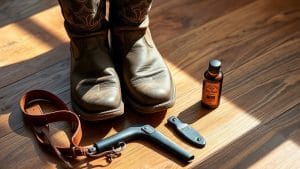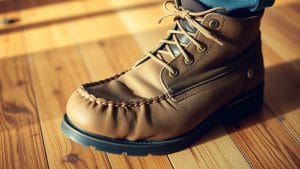This post contains affiliate links. As an Amazon Associate, we earn from qualifying purchases.
To break in leather boots effectively, start by accurately measuring your feet to ensure the right size. Opt for a gradual wear-in process by walking short distances, alternating with other footwear. Use thick socks to aid comfort and stretch the leather. Applying leather conditioner keeps boots supple, while gentle heat can help mold them to your feet. Regular cleaning and proper storage will enhance longevity. Discover further techniques to maximize your boot experience and comfort.
Key Takeaways
- Start by wearing your new leather boots for short periods (10-15 minutes) to allow them to flex comfortably.
- Alternate between your new boots and other footwear to minimize discomfort during the break-in period.
- Use thick socks to provide cushioning and help stretch the leather as you wear them.
- Apply gentle heat to tight areas using a hairdryer to help the leather mold to your feet.
- Regularly clean and condition your boots to maintain suppleness and enhance overall comfort during the break-in process.
Understanding Leather Types
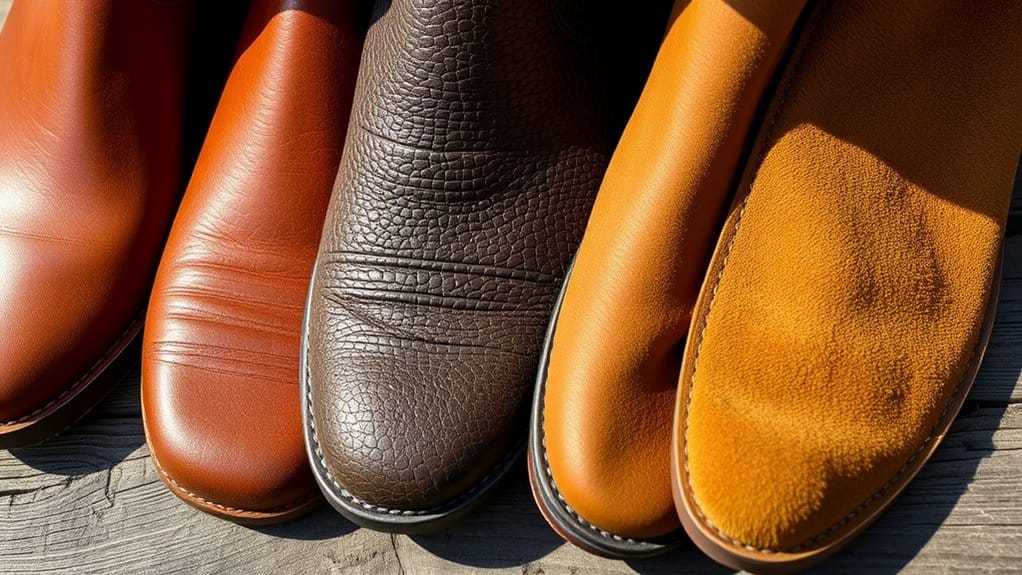
When you're breaking in leather boots, understanding the type of leather can significantly influence your approach. Various types of leather, such as full-grain, top-grain, and suede, each have distinct characteristics affecting their durability and break-in process.
Full-grain leather, known for its strength and breathability, might take longer to soften but will mold comfortably to your foot over time. In contrast, top-grain leather offers a more refined appearance while still providing decent durability, requiring less time to break in.
Suede, being softer, may feel comfortable right away but lacks some long-term durability. Knowing these differences is crucial; it helps you choose the right methods and products to ensure your boots last while providing the comfort you need.
Choosing the Right Size
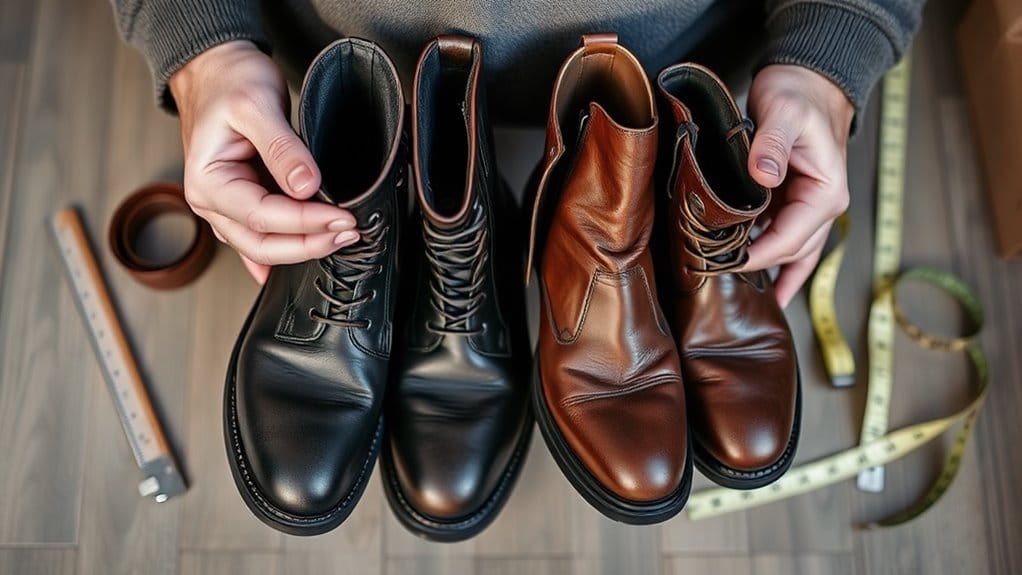
To ensure a proper fit, start by measuring your foot size accurately, as this is crucial for comfort and performance.
Don't just settle for one style; trying on different designs can reveal variations in fit even if the size is the same.
A well-fitted boot not only enhances your overall experience but also simplifies the breaking-in process.
Measure Your Foot Size
Choosing the right size is crucial, as improperly fitting boots can lead to discomfort and painful blisters.
Start by obtaining an accurate foot measurement. Use a ruler or a measuring tape to gauge the length and width of your foot, ideally at the end of the day when your feet are at their largest.
Stand on a piece of paper and trace your foot's outline, noting the widest and longest points. Compare these dimensions to the manufacturer's sizing chart for precise sizing.
Remember that different brands may have slight variations in their sizing, so always check. This careful approach ensures you select the best fit, maximizing comfort and minimizing the risk of blisters during the break-in period.
Try on Different Styles
After you've determined your correct foot size, it's time to explore different styles of leather boots that can accommodate your feet comfortably.
Each boot style offers unique features, so try on several to find the perfect fit. Consider classic options like Chelsea boots for versatility or combat boots for a rugged look.
Pay attention to the toe shape; round toes generally provide more room, while pointed styles can feel snug. Fashion trends influence materials and designs, so look for boots that reflect your personal style while ensuring comfort.
As you try on various options, walk around to assess the fit; your chosen pair should feel secure without pinching. This attention to detail will help you find boots that are both stylish and comfortable.
Gradual Wear-In Process
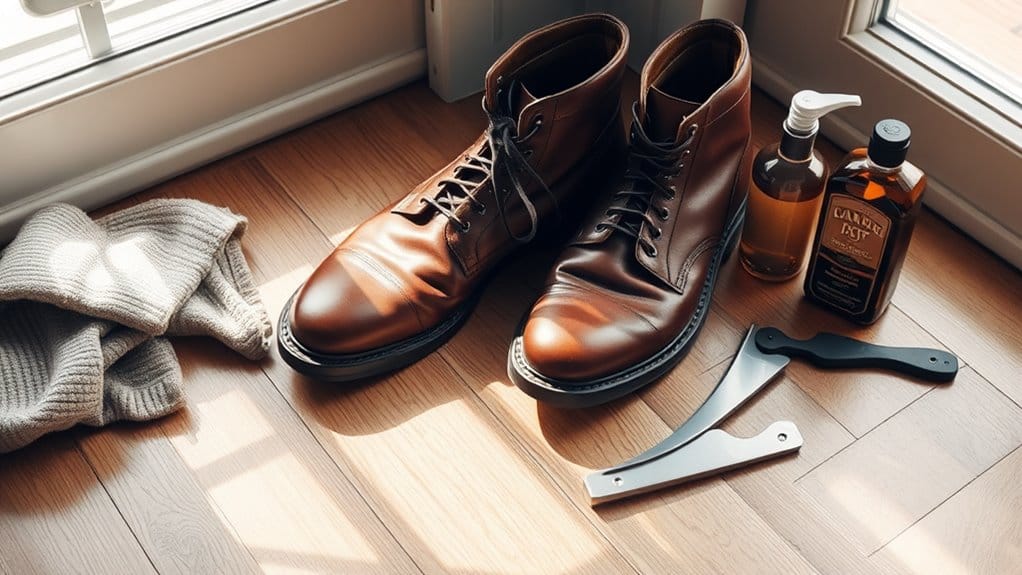
To effectively break in your leather boots, start with short walks to allow the material to flex and mold to your feet.
Alternate between your new boots and other footwear to minimize discomfort while promoting gradual adaptation.
Additionally, wearing thick socks can provide extra cushioning and help stretch the leather, ensuring a more comfortable fit over time.
Start With Short Walks
Starting with short walks is crucial when breaking in your leather boots, as it allows the material to gradually conform to the shape of your feet without causing discomfort.
Begin by taking your boots for short distances, ideally around 10 to 15 minutes. This initial exposure helps the leather soften and adapt to your foot's contours.
As you grow accustomed to the fit, gradually increase the duration of your walks. Pay attention to any pressure points or discomfort during these outings; they'll indicate where the material needs further stretching.
Alternate With Other Footwear
While you're breaking in your leather boots, alternating with other footwear is essential for a gradual wear-in process that helps prevent discomfort and injury.
By incorporating a footwear rotation, you give your feet a chance to recover from the stiffness associated with new boots. This practice not only reduces the risk of blisters but also aids in breaking habits that might lead to overuse injuries.
Wearing your boots for brief periods, then switching to more flexible shoes, allows your feet to adapt gradually, ensuring a more comfortable fit in the long run.
Aim for at least two or three different pairs in your rotation, allowing your leather boots to soften naturally while keeping your feet happy and healthy.
Use Thick Socks
Using thick socks can significantly enhance the comfort of your leather boots during the break-in period. By increasing the socks thickness, you create a buffer between your feet and the stiff leather, allowing the material to stretch gradually without causing discomfort.
Opt for socks made from breathable materials to maintain optimal comfort levels, preventing excess moisture buildup that can lead to blisters.
Start by wearing your boots for short periods, gradually increasing the duration as the leather begins to conform to your foot shape. This method not only speeds up the break-in process but also ensures a better fit in the long run.
Using Leather Conditioner
Applying leather conditioner is essential for maintaining the suppleness and durability of your leather boots, especially after they've been exposed to moisture or daily wear.
The leather conditioner benefits include preventing cracking, enhancing water resistance, and prolonging the life of your footwear.
To apply conditioner effectively, first, clean your boots with a damp cloth to remove dirt and grime.
Then, use a soft cloth or sponge to spread a thin, even layer of conditioner across the leather surface.
Pay special attention to seams and creases, where leather is most vulnerable.
Allow the conditioner to absorb for at least 15 minutes before buffing with a dry cloth.
This technique ensures your boots remain soft and comfortable while resisting damage from everyday use.
Applying Heat for Flexibility
To achieve a comfortable fit in your leather boots, you might consider applying gentle heat to soften the material, allowing it to mold to your foot's unique shape.
Start by identifying suitable heat sources, like a hairdryer on a low setting or a heat gun held at a distance. Focus on areas that feel tight, moving the heat source in small circles to promote even leather expansion.
Keep the heat application brief—around 30 seconds at a time—to prevent damage. Once the leather feels warm and pliable, slip your boots on and walk around, letting them contour to your feet.
Remember to let the boots cool while you wear them to maintain the new shape.
Walking on Different Surfaces
After warming and shaping your leather boots, the next step in the breaking-in process involves walking on various surfaces.
Start on soft, even walking surfaces like grass or carpet to allow the leather to flex gradually without excessive strain. Gradually progress to harder surfaces like concrete or gravel, which will help you assess the boot traction.
Pay attention to how the soles respond; this will inform you about their grip and stability. Alternating between different walking surfaces helps the leather mold to your foot's shape while adapting to diverse terrains.
If you notice any pinching or discomfort, adjust your walking pace and shift your weight to help the leather relax further. This methodical approach ensures a comfortable fit and maximizes the boot's performance.
Caring for Your Boots After Break-In
Once you've successfully broken in your leather boots, maintaining their condition becomes essential for longevity and performance.
Establish a maintenance routine that includes regular cleaning to prevent dirt and debris from damaging the leather. Use a soft brush to remove surface grime, and follow up with a damp cloth to wipe away any residual moisture.
Apply a high-quality leather conditioner every few months to keep the leather supple and prevent cracking. For waterproofing, consider a suitable spray or wax designed for leather.
Don't forget to store your boots in a cool, dry place, using boot trees to maintain their shape. By following these steps, you'll ensure your boots remain comfortable and stylish for years to come.
Frequently Asked Questions
How Long Does It Take to Fully Break in Leather Boots?
Breaking in leather boots typically takes about 2 to 4 weeks, depending on the leather quality and usage. Consistent wear combined with proper leather care ensures optimal comfort and durability, allowing your boots to mold perfectly to your feet.
Can I Wear Thick Socks During the Break-In Process?
Yes, you can wear thick socks during the break-in process. They help adjust the fit, enhancing comfort levels. Just ensure your boots aren't too tight, as that might hinder the natural stretching of the leather.
What if My Boots Still Feel Tight After Breaking In?
If your boots still feel tight after breaking in, consider professional boot stretching. Persistent tightness can lead to foot pain, so addressing the issue promptly ensures comfort and prevents long-term damage to your feet.
Is It Normal for Leather to Change Color While Breaking In?
Yes, it's normal for leather to change color during the breaking-in process due to moisture and oils in the leather. Proper leather care, like conditioning, helps maintain its appearance and prevents unwanted discoloration over time.
Should I Avoid Water While Breaking in My Leather Boots?
You should limit water exposure during the break-in process. Excess moisture can damage leather, affecting its shape and durability. Prioritize boot care by applying a waterproofing treatment after breaking them in to enhance longevity.
Conclusion
Breaking in leather boots doesn't have to be a painful experience. By understanding the leather type, ensuring a proper fit, and following a gradual wear-in process, you'll enhance flexibility and comfort. Utilizing leather conditioner and gentle heat can further expedite this process. Once broken in, maintain your boots with care to preserve their integrity. With patience and the right techniques, you'll enjoy the perfect blend of style and comfort in your leather boots for years to come.

